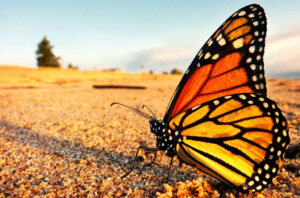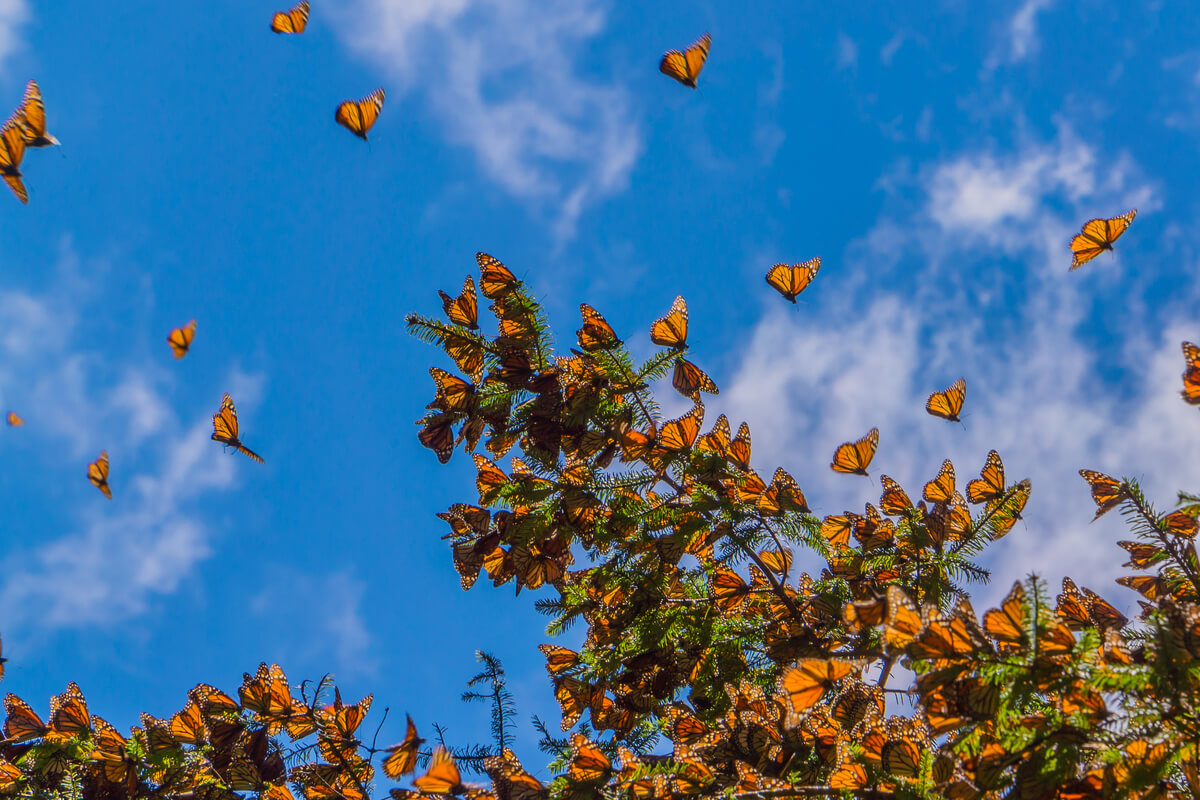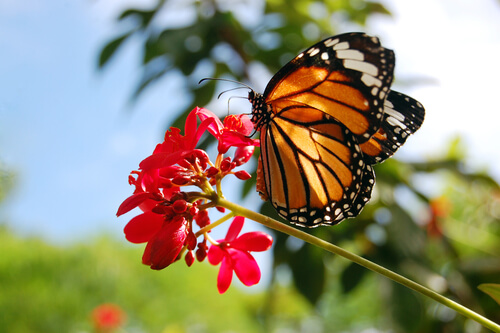Some Monarch Butterfly Populations Are Increasing: Is it Enough to Save Them?


Written and verified by the biologist Georgelin Espinoza Medina
There are many animals whose populations have decreased around the world for different reasons. Sometimes humans are to blame for this. Monarch butterfly populations are an example of those that struggle daily for their survival, victims of various factors and circumstances.
Its scientific name is Danaus plexippus, a lepidopteran with a very notable and distinguished intense orange coloration. It’s also famous for the fascinating migratory journey it undertakes every year. If you want to know more about this enigmatic animal, its characteristics, its threats and the current state of its population, be sure to read these lines, with the latest research details.
Characteristics of the monarch butterfly

This beautiful butterfly stands out for its bright orange color with black veins, during its adult stage. Females have thicker lines, while males have thinner lines and two dark spots (one on each wing) in the center of one of these veins. Their wingspan ranges from 8.6 to 12.4 centimeters (3.4 to 4.8 inches) and they weigh barely half a gram.
Although it seems fragile, this lepidopteran is capable of performing one of the most amazing migrations in the animal world, an event that can even be called magical because of its beauty. During their journey, they travel in large groups, guided by the sun and overcoming obstacles along the way. It’s a journey to the south to survive the cold winters of the United States and Canada.
The monarch butterfly isn’t only found in North America (although these are the ones that perform this amazing migratory journey). They can also be found in South America, the Caribbean, some Pacific Ocean islands, Australia, New Zealand, the Canary Islands and Western Europe.
In North America, there are two distinct populations of monarch butterflies, one eastern and one western. The eastern population hibernates in the fir or oyamel forests of the volcanic mountains of eastern Michoacán, in central Mexico. The western one winters in the forests of coastal California.
But not all generations are capable of this majestic journey of up to 4,000 kilometers (nearly 2500 miles). These warriors only appear in late summer and early autumn, and can live 7 or 8 months, unlike the rest of the monarchs, with a short life span of between 2 and 5 weeks.
Why are monarch butterflies in danger of extinction?
Several factors have threatened the survival of this captivating insect, such as predators and diseases. However, during the last decades, human beings have also caused this fatal event. Thus, we have other causes such as the following:
- Loss of habitat: These beautiful butterflies have suffered destruction of their home in recent years. On the one hand, in the United States, modern agricultural practices generate destruction, such as the disappearance of asclepias plants, indispensable for the feeding of this species in its caterpillar phase. In addition, logging of overwintering sites in Mexico is another serious problem.
- The use of pesticides and transgenic vegetables: Some herbicides cause damage to the butterfly. This is because they prevent the development of milkweed. Without these plants, D. plexippus can’t complete its life cycle, since it lays its eggs there. They also serve as food for the larvae. The use of transgenic corn and soybean plants that are tolerant to pesticides such as glyphosate has also increased the problem.
- Climate change: Monarch butterfly populations are also vulnerable to the effects of climate change. Their survival depends on their migratory movements. And these, in turn, are regulated by environmental conditions.
Are monarch butterfly populations increasing?
It’s no secret that during the last decades the number of monarch butterflies in the overwintering areas in Mexico and California has decreased, which has caused great concern about the future of this species. As we have seen, several factors affect their survival. However, it seems that all is not lost.
A recent study, published in the magazine Global Change Biology in June of this year, has provided some encouraging data. There have been more than 135,000 observations of adult monarchs in breeding areas, between the years 1993 and 2018, and an overall positive trend in summer populations.
Although declines have been observed in some important breeding sites in the United States, there are other sites with no apparent changes or even an increase in the number of butterflies. According to scientists, this robustness in summer populations has (so far) allowed the recovery of losses during the winter season.
However, some experts don’t agree with these interpretations, as, despite the overall positive trend, there are relevant breeding sites with declining numbers of butterflies. For example, in the Midwest corn belt, a crucial area for most of these insects.
What does the future hold for monarch butterfly populations?

Researchers are continuing to analyze monarch butterfly populations, as there are many factors involved in their life cycle. Thus, the complexity of the interactions in all the elements involved must be understood.
Although the results of some studies suggest an increase in the number of individuals, we mustn’t let our guard down and we should continue with conservation plans. Research provides a light in the darkness, but the future of these iconic and almost magical insects, due to their remarkable appearance, size and fascinating migration, is everyone’s task.
There are many animals whose populations have decreased around the world for different reasons. Sometimes humans are to blame for this. Monarch butterfly populations are an example of those that struggle daily for their survival, victims of various factors and circumstances.
Its scientific name is Danaus plexippus, a lepidopteran with a very notable and distinguished intense orange coloration. It’s also famous for the fascinating migratory journey it undertakes every year. If you want to know more about this enigmatic animal, its characteristics, its threats and the current state of its population, be sure to read these lines, with the latest research details.
Characteristics of the monarch butterfly

This beautiful butterfly stands out for its bright orange color with black veins, during its adult stage. Females have thicker lines, while males have thinner lines and two dark spots (one on each wing) in the center of one of these veins. Their wingspan ranges from 8.6 to 12.4 centimeters (3.4 to 4.8 inches) and they weigh barely half a gram.
Although it seems fragile, this lepidopteran is capable of performing one of the most amazing migrations in the animal world, an event that can even be called magical because of its beauty. During their journey, they travel in large groups, guided by the sun and overcoming obstacles along the way. It’s a journey to the south to survive the cold winters of the United States and Canada.
The monarch butterfly isn’t only found in North America (although these are the ones that perform this amazing migratory journey). They can also be found in South America, the Caribbean, some Pacific Ocean islands, Australia, New Zealand, the Canary Islands and Western Europe.
In North America, there are two distinct populations of monarch butterflies, one eastern and one western. The eastern population hibernates in the fir or oyamel forests of the volcanic mountains of eastern Michoacán, in central Mexico. The western one winters in the forests of coastal California.
But not all generations are capable of this majestic journey of up to 4,000 kilometers (nearly 2500 miles). These warriors only appear in late summer and early autumn, and can live 7 or 8 months, unlike the rest of the monarchs, with a short life span of between 2 and 5 weeks.
Why are monarch butterflies in danger of extinction?
Several factors have threatened the survival of this captivating insect, such as predators and diseases. However, during the last decades, human beings have also caused this fatal event. Thus, we have other causes such as the following:
- Loss of habitat: These beautiful butterflies have suffered destruction of their home in recent years. On the one hand, in the United States, modern agricultural practices generate destruction, such as the disappearance of asclepias plants, indispensable for the feeding of this species in its caterpillar phase. In addition, logging of overwintering sites in Mexico is another serious problem.
- The use of pesticides and transgenic vegetables: Some herbicides cause damage to the butterfly. This is because they prevent the development of milkweed. Without these plants, D. plexippus can’t complete its life cycle, since it lays its eggs there. They also serve as food for the larvae. The use of transgenic corn and soybean plants that are tolerant to pesticides such as glyphosate has also increased the problem.
- Climate change: Monarch butterfly populations are also vulnerable to the effects of climate change. Their survival depends on their migratory movements. And these, in turn, are regulated by environmental conditions.
Are monarch butterfly populations increasing?
It’s no secret that during the last decades the number of monarch butterflies in the overwintering areas in Mexico and California has decreased, which has caused great concern about the future of this species. As we have seen, several factors affect their survival. However, it seems that all is not lost.
A recent study, published in the magazine Global Change Biology in June of this year, has provided some encouraging data. There have been more than 135,000 observations of adult monarchs in breeding areas, between the years 1993 and 2018, and an overall positive trend in summer populations.
Although declines have been observed in some important breeding sites in the United States, there are other sites with no apparent changes or even an increase in the number of butterflies. According to scientists, this robustness in summer populations has (so far) allowed the recovery of losses during the winter season.
However, some experts don’t agree with these interpretations, as, despite the overall positive trend, there are relevant breeding sites with declining numbers of butterflies. For example, in the Midwest corn belt, a crucial area for most of these insects.
What does the future hold for monarch butterfly populations?

Researchers are continuing to analyze monarch butterfly populations, as there are many factors involved in their life cycle. Thus, the complexity of the interactions in all the elements involved must be understood.
Although the results of some studies suggest an increase in the number of individuals, we mustn’t let our guard down and we should continue with conservation plans. Research provides a light in the darkness, but the future of these iconic and almost magical insects, due to their remarkable appearance, size and fascinating migration, is everyone’s task.
All cited sources were thoroughly reviewed by our team to ensure their quality, reliability, currency, and validity. The bibliography of this article was considered reliable and of academic or scientific accuracy.
- Animal Diversity Web (ADW). Danaus plexippus. Recuperado el 17 de julio de 2022, disponible en: https://animaldiversity.org/accounts/Danaus_plexippus/#:~:text=D.,of%20asclepiad%20flora%20(milkweeds)
- Comisión para la Cooperación Ambiental (CCA). (2009). Monitoreo de la mariposa monarca en América del Norte: Resumen de iniciativas y protocolos. Canadá. http://www.cec.org/es/publications/monitoreo-de-la-mariposa-monarca-y-su-habitat-en-america-del-norte/
- Crossley M., Meehan T., Moran M., Glassberg J, Snyder W., & Davis A. (2022). Opposing global change drivers counterbalance trends in breeding North American monarch butterflies. Global Change Biology, 28(15), 4726-4735.
- Davis, A.; Crossley, M., Moran, M., Glassberg, J., & Snyder, W. (2021). No broad decline of breeding monarch butterflies in North America: implications for conservation efforts. https://www.biorxiv.org/content/10.1101/2021.08.03.454948v1.full
- Islas-Báez, A., Pérez-Miranda, R., González-Hernández, A., Romero-Sánchez, M., Velasco-Bautista, E. (2015). Riesgo del hábitat de la mariposa monarca (Danaus plexippus) ante escenarios de cambio climático. Ra Ximhai, 11(5), 49-59.
This text is provided for informational purposes only and does not replace consultation with a professional. If in doubt, consult your specialist.








